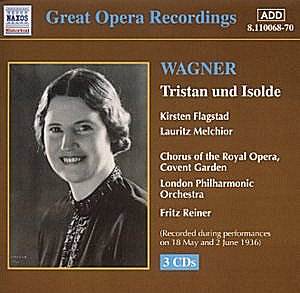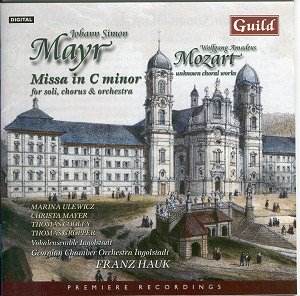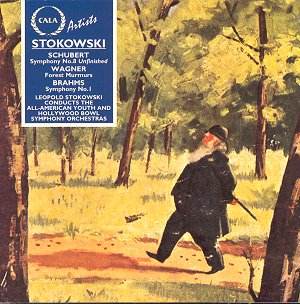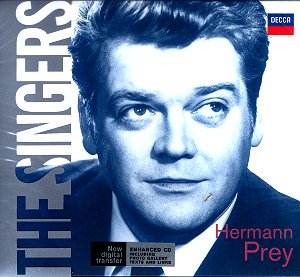 Composer: Richard Wagner
Composer: Richard Wagner
Works: Tristan und Isolde
Performers: Kirsten Flagstad (Isolde), Lauritz Melchior (Tristan), Sabine Kalter (Brangane), Herbert Janssen (Kurwenal), Emmanuel List (King Marke), Frank Sale (Melot), Roy Devereux (Sailor), Octave Dua (Shepherd), Leslie Horseman (Steersman), Chorus of the Royal Opera House, Covent Garden, London Philharmonic Orchestra, Fritz Reiner
Recording: Recorded at Covent Garden during performances on 18th May and 2nd June 1936
Label: NAXOS HISTORICAL 8.110068-70 [3 CDs 209.29]
Richard Wagner’s “Tristan und Isolde” stands as a monumental work in the operatic canon, a harbinger of modernity and emotional depth in its exploration of love and death. This recording, featuring the legendary pairing of Kirsten Flagstad and Lauritz Melchior, encapsulates a performance from an era when the very notion of recorded sound was still in its infancy. The historical significance of this document cannot be overstated; it offers a window into the operatic practices of the mid-20th century while simultaneously showcasing Wagner’s revolutionary score, rife with chromaticism and an emotional intensity that was groundbreaking for its time.
The interpretation under Fritz Reiner’s baton is particularly noteworthy. Reiner, then a young conductor, commands the Covent Garden orchestra with remarkable finesse. His ability to balance the overwhelming emotional weight of Wagner’s music with moments of intimate reflection is striking. Throughout the performance, he exhibits a meticulous attention to detail, ensuring that not a single bar seems neglected. This is particularly pronounced in the Prelude to Act I, where the lush orchestration gives way to a haunting sense of longing, a sonic representation of the opera’s central theme. The seamless transitions between the orchestral passages and vocal lines reveal Reiner’s deep understanding of Wagner’s harmonic language, often punctuating the drama with a touch of chamber-like intimacy that belies the grand scale of the work.
Kirsten Flagstad’s portrayal of Isolde is nothing short of iconic. Her voice, rich and formidable, carries the weight of the character’s passionate declarations with regal authority. The famous Love Duet in Act II exemplifies her expressive capabilities; both Flagstad and Melchior exhibit a profound sensitivity to the text, emphasizing the importance of the words alongside the music. Flagstad’s ability to convey the duality of Isolde’s regal stature and her passionate vulnerability is particularly moving, offering a striking contrast to Melchior’s portrayal of Tristan, who embodies the tortured hero with a resonant, heroic tenor that is both thrilling and heartbreaking.
Reiner’s orchestral direction enhances the dramatic tension throughout the opera. The second act, with its intricate web of orchestral color and vocal interplay, reveals the conductor’s knack for pacing and dynamic control. The woodwinds, featuring players like Leon Goossens and Bernard Walton, add layers of emotional nuance, particularly in the moments leading up to the climactic Love Duet. This section serves as a perfect example of how Reiner’s orchestration manages to elevate the singers, allowing their voices to soar without being overshadowed by the orchestral forces.
The recording quality, while limited by the technology of the period, has been expertly restored by Ward Marston, enabling contemporary listeners to appreciate the sonic landscape of 1936. The slight crackle of the 78rpm format only adds to the sense of historical authenticity, and the nuances of the performance still resonate powerfully. While the chorus may not reach the heights of the principals, and certain supporting roles are less memorable, the ensemble’s contributions are adequate enough to maintain the dramatic flow, allowing the focus to remain on the star pair.
This recording of “Tristan und Isolde” not only serves as a testament to the extraordinary talents of Flagstad and Melchior but also stands as a significant document of Wagnerian performance history. It provides an invaluable alternative to both Furtwängler’s studio recordings and Bohm’s interpretations, each of which offers its own insights into this complex score. The emotional rawness and interpretative depth achieved here are qualities that continue to resonate, making this set an essential addition for any serious Wagner enthusiast. The historical context, combined with the artistry of the performers and the insights of Reiner’s conducting, culminates in a performance that remains profoundly impactful, transcending the limitations of its time.



